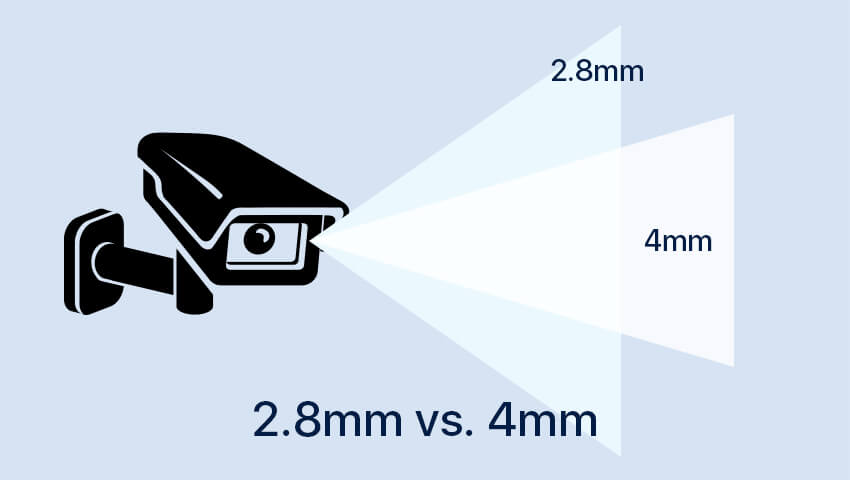When shopping for a security camera, you might notice terms like 2.8mm or 4mm lens listed in the specifications. These numbers might look small, but they have a big impact on what your camera sees.
Simply put, the lens focal length — measured in millimeters (mm) — determines how wide or narrow the camera’s view will be and how close or far objects appear in the video. A shorter focal length (like 2.8mm) means a wider view, while a longer one (like 4mm) means a narrower, more zoomed-in view.
To help you choose the right one for your space, let’s take a closer look at what these two lenses really do, their differences, and the benefits each provides.
Contents
Understanding 2.8mm and 4mm Lenses
What is a 2.8mm Lens?
A 2.8mm lens is a wide-angle lens that captures a broader field of view, usually around 100°–110° horizontally, depending on the camera’s image sensor.
This lens is ideal for open spaces or when you want to see an entire room or yard at once. However, because it’s so wide, distant subjects appear smaller and contain less detail.
What is a 4mm Lens?
A 4mm lens has a longer focal length, producing a narrower field of view — typically around 70°–80° horizontally.
While it doesn’t cover as much area, it brings distant objects closer, showing more detail on people, faces, or vehicles at medium range. This makes 4mm lenses great for focused monitoring, like entryways or driveways.
Key Differences Between 2.8mm and 4mm Lenses
1. Field of View
2.8mm: Wide (~100°–110°), captures more of the scene.
4mm: Narrow (~70°–80°), focuses on a smaller area.
2. Object Size in Frame
2.8mm: Objects appear smaller, less detail at a distance.
4mm: Objects appear larger, more detail at the same distance.
3. Coverage vs. Focus
2.8mm: Great for overall coverage of rooms, yards, or open spaces.
4mm: Best for targeted monitoring, such as doors, corridors, or driveways.
4. Detail Level:
2.8mm: Moderate; suitable for monitoring movement.
4mm: Higher; ideal for identifying faces, packages, or vehicles.
5. Installation Flexibility:
2.8mm: Works well in corners or ceilings for wide-area surveillance.
4mm: Requires precise aiming to cover critical points effectively.
Summary: 2.8mm = wider coverage with smaller details; 4mm = narrower coverage with clearer details.
Benefits of 2.8mm and 4mm Lens
Benefits of 2.8mm Lens
• Wide coverage: Captures a larger area, reducing the number of cameras needed to monitor an entire room or outdoor space.
• Better situational awareness: Ideal for monitoring overall movement and activity rather than focusing on specific details.
• Versatile installation: Works well on walls, ceilings, or corners to cover open spaces effectively.
• Cost-efficient: Fewer cameras can cover more area, lowering overall system cost.
• Quick overview: Great for business floors, backyards, parking lots, or living rooms where general surveillance is the priority.
• Reduced blind spots: The wide-angle view helps ensure no part of the monitored area is left unobserved.
Benefits of 4mm Lens
• Enhanced detail: Provides clearer images of faces, license plates, or objects at a distance.
• Focused monitoring: Perfect for targeted areas like entrances, corridors, or driveways.
• Improved identification: Narrower field of view allows objects to appear larger in the frame, making identification easier.
• Security-critical points: Ideal for zones where accurate recognition is more important than covering a wide area.
• Reduced distortion: Produces a more natural perspective with less stretching at the edges compared to wide-angle lenses.
• Professional surveillance: Suitable for locations requiring close observation, such as front doors, hallways, or property perimeters.
Typical Use-Cases — Which Should You Choose?
Your ideal choice depends on what you want to monitor.
Choose 2.8mm when:
You need broad coverage (living room, retail floor, backyard, wide driveway).
You want to monitor movement and activity across a larger area rather than read fine detail.
Ceiling or corner mounting where the camera must see a full room or wide yard.
You prefer fewer cameras for full-area coverage (cost-efficient).
Use case examples: Indoor living room, storefront floor, or small-to-medium parking lot where you want to see people’s movement and overall scene.
Choose 4mm when:
You need better subject detail (face recognition at medium range, identifying packages, reading parts of license plates at a modest distance).
The scene is a corridor, narrow entrance, driveway or focused area where you want more magnification.
You can aim the camera precisely at an expected zone of interest.
Use case examples: Entryway facing the front door, narrow hallway, small shop checkout lane, or driveway where plate/face detail at ~5–15 meters matters.
FAQs
Q: Can I replace a lens later if I pick the wrong one?
A: Some professional cameras have interchangeable lenses; many consumer cameras do not. Check the model specs. For fixed-lens cameras, choose based on expected placement.
Q: Which lens is better for 4K cameras?
A: Higher resolution helps regardless of lens — but a 4mm on a 4K sensor will deliver stronger identification detail than a 2.8mm on the same sensor when your subject is in the same area of the frame.
Q: What about varifocal/zoom lenses?
A: Varifocal lenses (e.g., 2.8–12mm) give flexibility for different situations but cost more and require adjustment during installation.
Conclusion
Both 2.8mm and 4mm lenses have their strengths — the key is matching them to your monitoring goals.
2.8mm: See more, ideal for overall coverage.
4mm: See clearer, ideal for detail capture.
If you’re setting up a ZOSI security system, consider using both for full protection — a 2.8mm for the big picture and a 4mm for the close-up details that matter.

